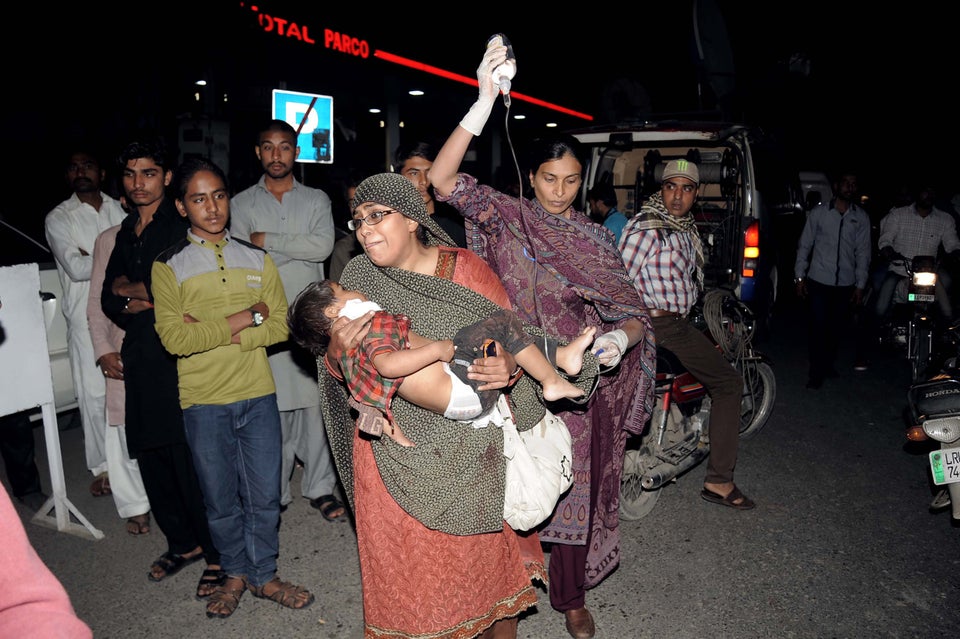Faces
The Huffington Post published a string of photos of the aftermath of the Lahore bombing. There are no gory ones, but there are many anguished faces.

K.M. Chuadary/ASSOCIATED PRESS
A woman weeps for her injured family members as she tries to speak to security at a local hospital in Lahore.

Arif Ali/Getty Images
A Pakistani family brings an injured child to the hospital in Lahore on March 27, 2016.

Heartbreaking.
Maybe I’m biased and callous, but it seems to me the women are grieving and trying to save lives, while the [non-female gendered cis] hang around with their arm crossed, trying to look away or at least look serious.
BTW, I’m also tired, hungry and – not least – privileged.
I had similar thoughts while looking at the pics but, to be fair, it’s only a tiny selection from what are probably thousands of photos taken by hundreds of people. There was one much-shared photo of two men crying together, which didn’t happen to be in this collection.
I wonder, now and then, whether the people who involve themselves especially in the more organized and planned forms of violence, like terrorism and warfare (other, of course, than the suicide bombers, who avoid facing it in quite drastic fashion) ever look at photos like these. And what they think if and when they do.
It’s this odd thing about our world: our telecommunications prowess means we can get images like this from halfway around the world, on demand, almost instantaneously. Grief and viscera, as much as you care to face. But people somehow still manage not only to contrive to rend bodies irreversibly, irreparably, and thus fatally, with devices design to fling shredding, jagged metal through them, but _plan_ to do so in highly organized fashion, frequently in the context of elaborate, far-flung organizations arranged for exactly this purpose, and methods requiring extensive planning…
The sorta standard pop culture explanations I get are that there’s generally a level of dehumanisation involved, outside almost inevitably some kind of abstraction, beyond the socialization within the structure that demands this. A ‘higher’ ideal is good, too, and so much the better, I guess, if you can assure yourselves an unimpeachable sky tyrant approves (are gods the ultimate Milgram authorities?). But back at dehumanisation, yes, those screaming and gasping their last breaths as their blood soaks pavement and drywall–and presumably those wailing their grief, or, worse, standing too stock still, as it shatters them–are vermin or traitors or inhuman robots out to destroy all that is good and just…
Do the photos affect people, after they’ve convinced themselves of this? Or do they just feel contempt? We can see so much, so easily, and we can see so far. And still it’s bombs and shrapnel, requiring building, planning, premeditating, well in advance: I’m _going_ to do this to someone. There’s a _schedule_. On this date, this happens, and I do it…
The suicide bomber, sure, is heavily indoctrinated, possibly even bullied and browbeaten, and won’t be around to see these, but someone else probably wired the vest, prepared them. They may, in this case, imagine themselves ‘holy men’, and this was a divine duty. The pilot has the insulating effect of altitude and technologies that deliver the weapon somewhat more impersonally, but presumably has an internet connection at home. He is told: you must; these are orders, threats that must be neutralized. Probably, he at least hopes his targets are chosen to be those who actually would do such things as these, figures there are worse things (and I would, honestly, tend to agree, while also hoping their must be better), but then, sometimes, he knows he may later hear otherwise…
Somehow, we manage. We take vivid photographs, and maybe some of us look at them, but we still build and use bombs. There is always some reason, apparently compelling enough. Gods or their implacable (self-described) servants, and this is what we use as the tool, all the same.
(… erm… _there_ must be better. Grumble.)
Yes. I wrote about that whole thing for my next Free Inquiry column. It took a lot of wrestling.
It is of course one major reason I publish photos and biographies on some of these massacres – the one in Charleston, the one in Garissa, Kenya, the one in Nairobi, the one in Peshawar, the Bangladeshi bloggers. I want to do my tiny bit to get them into circulation, in hopes of putting people off.
There is always selection bias in any news. But still.
Ophelia, you do admirable and hard work for good causes. (I’m fed now ;) )